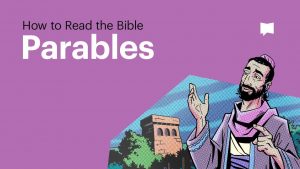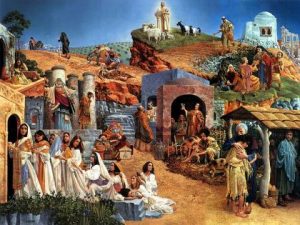
Shownotes
Welcome to Day 1376 of our Wisdom-Trek, and thank you for joining me.
I am Guthrie Chamberlain, Your Guide to Wisdom
Mastering the Bible – Old Testament Jesus and His Parables – Worldview Wednesday
Wisdom - the final frontier to true knowledge. Welcome to Wisdom-Trek where our mission is to create a legacy of wisdom, to seek out discernment and insights, and to boldly grow where few have chosen to grow before.
Hello, my friend, I am Guthrie Chamberlain, your captain on our journey to increase wisdom and create a living legacy. Thank you for joining us today as we explore wisdom on our 2nd millennium of podcasts. Today is Day 1376 of our trek, and it is Worldview Wednesday. Creating a Biblical worldview is essential to have a proper perspective on today’s current events. To establish a Biblical Worldview, you must have a proper understanding of God and His Word.
Our focus for the next several months on Worldview Wednesday is Mastering the Bible, through a series of brief insights. These insights are extracted from a book of the same title from one of today’s most prominent Hebrew Scholars, Dr. Micheal S. Heiser. This book is a collection of insights designed to help you understand the Bible better. When we let the Bible be what it is, we can understand it as the original readers did and as its writers intended. Each week we will explore two insights.
Mastering The Bible – Old Testament Jesus and His Parables
Insight Fifty-Nine: Gospel Writers Connect Jesus to the Old Testament in Both Transparent and Roundabout Ways
Since the New Testament begins with the Gospels, and Jesus is the focus of those first four books, we tend to think of Jesus exclusively in New Testament terms. That’s too narrow a perspective. The coming of the Messiah, the Son of God, is rooted in the Old Testament, not only in terms of prophecy but also imagery.
We’ve already talked about the most obvious way the Gospel writers associate Jesus with the Old Testament: calling him the Anointed One (“Christ”). Other transparent correlations extend from that messianic title. The Gospel writers quote specific prophecies about the birthplace of the Messiah (Matthew 2:6: John 7:42; cf. Micah 5:2) and the lineage of the Messiah (Matthew 1:1; cf. 2 Samuel 7:12-16; Psalm 132:11; Isaiah. 11:1).
Less obvious, but still familiar, connections are made between Jesus and the Old Testament in other ways. When John calls Jesus the “Word,” that label is not original to him. The God of Israel appeared to people in the Old Testament as the “Word” (John 1:1, 14: cf. Genesis 15:1-6: Jeremiah 1:1-9). And the title “Son of Man” had royal messianic meaning (Matthew 26:64; Daniel 7:13—14).
But the Gospel writers tether Jesus to the Old Testament in cleverer, less overt ways. For example, Matthew wants readers to identify Jesus with the nation of Israel. He accomplishes that in his story of Jesus’s childhood. After Joseph and Mary had to flee to Egypt to escape Herod, Matthew quotes Hosea 11:1, "When Israel was a child, I loved him, and I called my son out of Egypt," to
recount how they returned to the Promised Land. But God’s son in Hosea 11:1 wasn’t the Messiah; it was the nation of Israel. Matthew used the analogy for several reasons, but one of them was that Jesus had appeared on the scene supernaturally, just like Israel appeared as the result of divine intervention with Abraham and Sarah. Israel would later pass through the sea and then journey into the desert where the nation would be tried and tempted (Exodus 14-15; Numbers 14:26 ff.). After Jesus was baptized, he was driven into the wilderness to be tempted by Satan (Mark 1:9-13).
Jesus is also cast as a new Moses by the Gospel writers. When Moses was born, Pharaoh had all the infant boys killed (Exodus 1:22-2:10), and Jesus was likewise threatened by Herod (Matthew 2:13-18). Moses went up on a mountain to receive the Law (Exodus 19:3); Jesus ascended a mountain to give his own “law,” the Beatitudes of the Sermon on the Mount (Matthew 5:1).
Links back into the Old Testament are strewn throughout the Gospels. They also appear in other parts of the New Testament. Paying careful attention to how writers quote the Old Testament, where Jesus goes, and what he says at a given location will help you see them.
Insight Sixty: Parables Are Puzzling but Surprisingly Consistent

It’s no secret that parables present interpretive problems. A parable is simply a short story that has a double meaning. That is, there’s the obvious meaning of the story and then some other more abstract meaning conveyed by the story. The stories Jesus told were very simple, so you’d think both interpretations would be easily discerned. Not really.
Many writers, preachers, and Bible readers have approached the parables for centuries as though they are allegories. In an allegory, all the characters, events, and objects in a story have a specific meaning. But parables really aren’t like that. More recent scholarship on the parables rejects that approach since it’s artificial and contrary to what you actually read in the Gospels. When Jesus interprets parables for his disciples, he usually zeroes in on one or two teaching points. He doesn’t assign meaning to everything or everyone in the parables.
Jesus actually told the disciples why he taught in parables—and therefore tells us. He draws out the reason by quoting Isaiah 6:9-10 in Mark 4:11-12.
He replied, “You are permitted to understand the secret of the Kingdom of God. But I use parables for everything I say to outsiders, so that the Scriptures might be fulfilled:
‘When they see what I do,
they will learn nothing.
When they hear what I say,
they will not understand.
Otherwise, they will turn to me
and be forgiven.’”
What Jesus said isn’t hard to parse. Parables are meant to obscure and reveal the kingdom of God—which is not so much a place as it is the status of being part of God’s family and a follower of his good rule. Jesus taught in parables to convey who he was and what God was up to by sending him. Believers would understand. The spiritually blind and hard of heart would not.

As a result, when reading and interpreting parables, our eye needs to be trained to what they tell us about these things—how they reveal the kingdom of God and its King. The elements of the stories that do that are the important ones. Characters and components on the periphery shouldn’t be assumed to have meanings or to serve as elaborations on the central idea that we need to figure out. If we stray from what Jesus tells us to see in parables, our unchecked imaginations will have too much influence over our thinking.
That will conclude this week’s lesson on another two insights from Dr. Heiser’s book Mastering the Bible. Next Worldview Wednesday, we will continue with two additional insights. I believe you will find each Worldview Wednesday an interesting topic to consider as we build our Biblical Worldview.
Tomorrow we will continue with our 3-minute humor nugget that will provide you with a bit of cheer and help you to lighten up and live a rich and satisfying life. So encourage your friends and family to join us and then come along with us tomorrow for another day of our Wisdom-Trek, Creating a Legacy

If you would like to listen to any of our past 1375 treks or read the Wisdom Journal, they are available at Wisdom-Trek.com. I encourage you to subscribe to Wisdom-Trek on your favorite podcast player so that each day’s trek will be downloaded automatically.
As we take this trek together, let us always:
- Live Abundantly (Fully)
- Love Unconditionally
- Listen Intentionally
- Learn Continuously
- Lend to others Generously
- Lead with Integrity
- Leave a Living Legacy Each Day
I am Guthrie Chamberlain reminding you to Keep Moving Forward, Enjoy Your Journey, and Create a Great Day Everyday! See you tomorrow!